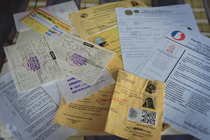- Home
- Videos
- Links
- Working with Interpreters
- Favorite Products
-
Newsletters
- December 2017
- December 2014
- June 2014
- March 2014
- December 2013
- November 2013
- October 2013 Newsletter
- July 2013 Newsletter
- June 2013 Newsletter
- March 2013
- February 2013
- January 2013
- December 2012
- November 2012
- October 2012
- September 2012
- August 2012
- July 2012
- June 2012
- May 2012
- April 2012
- March 2012
- February 2012
- January 2012
- November 2011
- October 2011
- September 2011
- August 2011
- July 2011
- March 2011
- February 2011
- January 2011
- October 2010
- September 2010
- May 2010
- April 2010
- March 2010
- September 2009
- May 2009 Remastered
- April 2009 Remastered
- February 2009 Remastered
- Healthy Body and Soul
- Upcoming Seminars
- More...
- COVID info for Medical interpreters
December 2013 Newsletter
In this edition:
To Translate or Not to Translate
Alcohol Monitoring Bracelet
The Waterproof Keyboard
Is My Interpreter Competent?
New Civil Court Glossary
This month's Favorite Link
Example of Bad Translation- A Real Court Form
What is a Waxing Moon?
To Translate or Not to Translate
Alcohol Monitoring Bracelet
The Waterproof Keyboard
Is My Interpreter Competent?
New Civil Court Glossary
This month's Favorite Link
Example of Bad Translation- A Real Court Form
What is a Waxing Moon?
I would like to thank all the interpreters for making time to come the Interpreter's Cafe in Wilmington. Carlota, Magdalena, Maria, Grettel, Catalina, Alina, Richard, Ana, Linda, Beatriz, Nelly, and Arturo are present in body or spirit at our meetings. Please remember that everyone is welcome and if you cannot sit at the Cafe, you can email your ideas, glossaries, problems, praises, or anything that's on your mind any time. Our next meeting is February 21st. I hope to see you there!
Thank you Carlota for your tip on Google alerts. Your curiosity and open mind are a blessing. Thank you Maria for discussing the RFP forms and clarifying their proper uses. You stayed with me after the meeting and we talked about the transdermal monitor. Your background in chemistry led me to search for information I would not have thought of on my own.
Welcome back Betsy from your trip to Antarctica!
Thank you Carlota for your tip on Google alerts. Your curiosity and open mind are a blessing. Thank you Maria for discussing the RFP forms and clarifying their proper uses. You stayed with me after the meeting and we talked about the transdermal monitor. Your background in chemistry led me to search for information I would not have thought of on my own.
Welcome back Betsy from your trip to Antarctica!

TO TRANSLATE OR NOT TO TRANSLATE We have all been asked to check someone’s homework, look over a letter for a friend, or quickly convert a few sentences into a foreign language. Translating for people we know may seem informal and stress-free because the text is concise and familiar, but there is no such thing as an informal translation, so beware. If you agree to translate something at work, you may be paving the road to your own misfortune. Bilingual employees are exceptionally valuable. They are sometimes the only link between products offered and foreign clientele. Sometimes, however, supervisors believe that all bilingual persons can also translate, interpret, or both. This is a serious misconception. Accepting an employee's offer to translate a sign, form, or document when the employee was not hired as a translator should not be done. Asking a bilingual employee who was not hired to translate or interpret is a huge imposition. If the employee does accept, publishing the work with no assessment or proofreading is irresponsible. We must all be prudent. This is especially true when a translation is meant to be read by members of the public. Here are a few tips that may help an employee decide whether to accept or reject a translation-request when somebody approaches him or her at work: If you were hired as a bilingual employee, not as a translator or interpreter, you may or may not be capable of executing translations. If in your foreign language you are at the “advanced” level of proficiency or higher, or if in your language-pair you are at translation “Level 2+” or higher, you probably are capable of doing simple translations. You can investigate these levels later by using the links provided in the last paragraph of this article. Simple translations are, for example, signs identifying offices or rooms, special requests such as no smoking, no eating, or silence, explaining intake procedures, directing customer flow, etc. Warning signs, medical instructions, legal notices, forms, or any other text that may result in the reader becoming injured, ill, confused, or charged with a crime due to readers' misunderstanding of the message should always be done by a professional translator, no matter how easy or mundane the text seems. If you feel confident executing simple translations, you may accept, but remember to have a professional translator or interpreter check your work. This will allow you to correct your mistakes, plus it will give you a chance to learn new words and expressions. If you do not feel comfortable when asked to do a translation, you should not accept. Simply explain to your boss that the translation is outside your range of expertise and recommend he or she seek a professional translator skilled in that particular subject matter. If you accept, you will be responsible for the result. Proper language to language rendition is one of the many duties of a professional translator, hence the “Translator’s Certification.” By accepting a task outside your area of expertise you are not only taking work away from a professional translator, but you may also be putting your own job in jeopardy. The different levels of translation are described at the Interagency Language Roundtable website. You can consult the levels of proficiency by visiting the American Council on the Teaching of Foreign Languages. 
TECHNO GADGETS
Remove germs and crumbs from your desktop with this washable keyboard. It's compatible with Windows operating systems and ideal for your desktop computer in your office or home. It's manufactured by Logitech and the one in the photo is model K310. It can be wiped clean, but it can also be submerged in water. Do not try placing it in the dishwasher though. The Logitech K310 comes with a tiny brush to clean between the keys (just look for it snapped cleverly on the back face.) This keyboard is not a soft rubber keyboard. It's a full size, rigid board that unplugs and goes straight under the kitchen faucet. It's great for flu season, all for the price of $34.00. 
If you don't understand the interpreter’s language, how do you know the interpreter is competent? Inquire as to the interpreter's credentials, years of experience, and area of expertise. When you first work with an interpreter, pay attention and try to see if: -The pace of the communication seems to flow -The interpreter does not hesitate or mumble -The interpreter does not engage in private conversations with the party or parties -You hardly even notice the interpreter -The interpreter may occasionally ask for clarification of meaning before interpreting -If a conversation suddenly begins among the non-English speakers, the interpreter will interpret everything into English for you... These are good indications of competence. 
New Civil Court Glossary A certified copy is a duplicate of an original document that is certified as a true copy by the officer having custody of the original. Notaries of Alaska, Illinois, Louisiana, Maine, Michigan, Mississippi, New York, New Jersey, North Carolina, Ohio, Rhode Island, South Carolina, South Dakota, Tennessee, and Wyoming are prohibited from issuing certified copies of any records or documents. Requests for certified copies should be directed to the agency that holds or issued the original document. T.P. No: Tarjeta profesional Numero: Professional ID Number Ejecutoria de sentencia: Final Judgement (even though it can be appealed, it is not. Copia autorizada o copia auténtica: Se refiere siempre a una copia notarial. Es la reproducción total o parcial de una matriz (escritura o acta) a petición de parte interesada y autorizada por el notario que tiene a su cargo el protocolo. Puede ser el mismo que autorizó la matriz o su sucesor en el protocolo. La copia autorizada, por definición legal, es documento público con todos los efectos inherentes a este tipo de documento. Tiene un formato específico: ha de extenderse en papel timbrado numerado, debe ser rubricada por el notario en todas sus hojas, con el sello de seguridad en la última y, asimismo, con el signo y firma del notario al final. En EEUU: Certified Copy Ejemplo. El notario que autorizó la escritura o acta original puede expedir copia autorizada de la misma, pero si después se jubila o cambia de plaza, o simplemente está de vacaciones, un sustituto podrá hacerlo en su lugar. Copia electrónica: Se trata de la reproducción del protocolo, bien en forma de copia autorizada, bien como copia simple, en soporte electrónico y no en soporte papel. Este tipo de copias son una creación de la ley 24/2001, de Acompañamiento a los Presupuestos del 2002 y, en especial, de los artículos 106 a 115. Este último modifica a su vez la Ley del Notariado, añadiéndole un nuevo artículo, el 17 bis de Colombia. La regulación de la copia autorizada electrónica es diferente de la copia en papel, puesto que solamente puede ser expedida para ser enviada a una serie limitada de destinatarios y, además, únicamente puede ser usada para una finalidad concreta, que debe constar en la misma copia. Ejemplo: En la constitución telemática de la SL Nueva Empresa, se produce un envío de copia electrónica autorizada al registro mercantil para su inscripción. Copia simple: Reproducción total o parcial de una matriz, con carácter exclusivamente informativo, a petición de parte interesada y autorizada por el notario que tiene a su cargo el protocolo. La copia simple suele ser una reproducción del contenido del documento, al que se añade el sello de cada notario. Puede también revestir el formato de copia electrónica. Un uso típico de esta copia es el de servir para entregarla a Hacienda (departamento que recauda impuestos inmobiliarios) en el momento de abonar los impuestos correspondientes. |

TRANSDERMAL ALCOHOL MONITORING SYSTEM Trans-dermal means through the skin. The transdermal method can be used for monitoring or delivering natural or synthetic chemicals which travel in or out of the skin. An example of transdermal delivery is a nicotine or hormone patch. An example of transdermal monitoring is a glucose or alcohol meter. The main component of perspiration is water. Perspiration also contains minerals, lactate, and urea. People perspire so that the water can cool their bodies, but perspiration also plays a role in the excretion of toxins and waste. The chemical composition of perspiration varies from individual to individual and even in the same person, sweat can change depending on what the person has been eating and/or drinking, why he or she is sweating, how long he or she has been sweating, and several other factors. A transdermal alcohol monitor is used to force, maintain, or prove sobriety. When a person drinks alcohol, the alcohol begins to travel through the digestive system to finally reach the liver where it is metabolized, like most toxins, in order to keep the body healthy. Alcohol, however, is soluble in water, so before the alcohol is absorbed by the walls of the stomach and small intestine, and then metabolized in the liver, about 1% escapes into the skin and is later released through natural perspiration. This is where the monitoring device comes in. Transdermal alcohol testers really measure the concentration of ETHANOL in a person's perspiration. The tester does not actually absorb the sweat, but rather captures the ethanol released into the air at the surface of the skin. If a person has been drinking alcohol, this can be detected by the level of ethanol vapor present in their perspiration through two processes: passive diffusion through the skin and active excretion from the sweat glands. Transdermal testing cannot determine the exact blood-alcohol concentration (BAC) levels, but it can be used to calculate the amount of alcohol the wearer has consumed based on the transdermal alcohol content (TAC). Studies done over the years, such as the Transdermal Alcohol Measurement: A Review of the Literature by J.S. Hawthorne and M.H. Wojcik, show that TAC results correlate well with BAC results. However, because of the way alcohol is absorbed and processed by the body, TAC peaks are typically reached 30 minutes to two hours after BAC peaks. Several methods have been used to estimate the consumption of alcohol and attempted to measure ethanol in sweat. The most popular method used today is the SCRAM. It is an electromechanical system that consists of a monitoring bracelet, a home-base station, a computer software program, and the internet. SCRAM stands for secure continuous remote alcohol monitoring system. The SCRAM bracelet has fiber optics within its straps. If the fiber-optic lines are cut, the light of the fibers does not pass from one section to the other and an alarm is activated. The bracelet automatically monitors the alcohol through the skin twice every our. The accuracy of the monitor is 99%. The software creates a curve unique for each individual. When a “spike” is registered, it must be investigated and verified by a human. Only then is a report created for what the service providers calls “a drinking episode.” “Drinking episodes” and “spikes" are not the same thing, because a “spike” may be caused by a “false positive.” In order to avoid false positives, which are in some cases triggered intentionally to hide drinking, the wearer must sign an extensive agreement. This agreement explains that the user is prohibited not only from ingesting alcohol, but also of being in contact with alcohol, whether the alcohol be in the environment or in products placed directly on the skin. These products may include mosquito repellent, hairspray, body wash, volumizing shampoo, mouthwash etc. The agreement also describes how much the wearer will have to pay if the equipment is damaged or destroyed (by tampering, swimming, bathing, etc. You can view a real agreement by clicking here. Once the agreement is signed, the monitoring bracelet is placed on one of the user’s ankles where it continuously captures the perspiration and wirelessly sends information to the base-station in the user’s home. The boxy part of the bracelet contains the monitors. The monitors are not a "near infrared light" as people may think. The near infrared light, such as the one used in continuous glucose meters must be placed onto a thin portion of the body, such as the earlobe, so the light can go in one side and come out the other to be captured by the receptor-face of the monitor; there cannot be a large bone between the two sides of the infrared beam. The monitor on the SCRAM bracelet is actually a combination of an electronic air-monitoring device and an inner absorbancy pad. This is why ethanol readings are not affected by showering, but bathing will activate the remote alarm. Sometimes the grates on the bracelet "boxes" get very dirty and/or become layered with oils, dead skin, and other residue. This may create tampering alerts also. This is usually corrected by the probation officer thoroughly cleaning the inner face of the bracelet boxes with soap and water. The bracelet reads 24 hours a day, 7 days a week and the base-station in the user’s home also works 24/7. Data, such as chemical reports and tamper-test reports, are sent from the bracelet to the base unit every 30 minutes and automatically downloaded to a predetermined network. The use of these systems is usually ordered by the court, although a court order is NOT required to purchase or use the system. Sometimes people utilize the transdermal monitoring devices voluntarily to help achieve sobriety or to prove sobriety. The bracelets may create redness and sores on the leg and wearing a SCRAM requires serious lifestyle awareness and change. These systems are manufactured by private companies and purchased from an authorized systems-service provider. The cost of the equipment, repair, and daily service are usually responsibility of the user, although if the system is ordered by the court, the user is only responsible for repair and daily service which is about $8.50 a day plus a one-time installation fee of $40.- THIS MONTH'S FAVORITE LINK
Google Alerts: Sign-up and type a keyword for a subject that interests you, such as INTERPRETERS. Google will email you articles related to your chosen key words. It's great! Thank you Carlota for this useful tip! 
Waxing and Waning Moon
To identify a Waxing or Waning Moon one must determine which side is "incomplete". When the Moon is illuminated in such a way that the side facing West is "incomplete" the Moon is Waning (getting smaller). If the side to the East is "incomplete" the Moon is Waxing (getting bigger.) In Spanish we call these "luna menguante" y "luna creciente". 
Examples of Bad Translation- Real Court Paperwork Not long ago, in January 2014, a defendant showed me an official notice. I won't say from what state, but I can proudly say that is was not from Delaware. I was compelled to copy some of the sentences because they were so badly translated I was shocked. Below are some of the sentences exactly as they were on this English/Spanish subpoena: Use this return pre-paid envelope./ Use el sobre proveado que está estampillado. I acknowledge receipt of this subpoena and will appear as ordered./Yo admito haver recibido ésta cita comparecere como es ordenado. |

